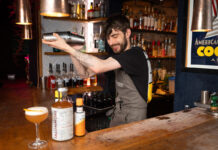Broadening consumer tastes bring opportunities, firms say

THE ale category has been a hive of activity in recent years with new faces and perhaps even new ‘sub-categories’ emerging.
And such activity might just have given ale a boost, as Alasdair Bayne of Tennent Caledonian Breweries, the firm behind Caledonia Best, told SLTN that a decline in overall sales of ale “has shown recent signs of slowing”.
Bayne said he was encouraged by an improvement in the ‘smooth ales’ sub-category, of which Caledonia Best is a part, crediting the growth to a “swing” from traditional draught ale to smooth ales; this, along with growth in the craft and cask sub-categories, forms part of a general trend, according to Bayne.
“The trade in general is modernising in a lot of areas, particularly in city centres,” said Bayne.
“I think for us what’s been helping drive the growth is we’ve had a few campaigns behind it [Caledonia Best].”
The target age group for ale might traditionally have been a little higher than that for lager, but Bayne said age profiles are shifting.
“You find that people tend to have a repertoire of drinks,” he said.
“You can less and less rely on segmentation by age group and you have to look at consumer habits.”
With this in mind, he suggested operators look to their bottom line when building an ale range.
“When looking at it from a licensee’s perspective you have to consider being profitable in the areas you sell most of,” said Bayne.
“Craft beer is important and growing but a pub will still sell more lager.
“So you have to look at wherever you sell the most of your ale and make sure you get the good, recognised and popular brand in there.
“But there’s always opportunity to rotate and that’s where cask comes into its own.”
When it comes to cask ale, Matthew Clark product marketing manager Justin Wylde claims the Scottish trade has seen “definite growth” in the category, highlighting CGA data which showed a 9.2% increase in volume sales for the four months to June of this year compared with the previous quarter.
Wylde also pointed to research showing that 20% of cask ale drinkers are now aged under 35.
“As new drinkers come into the category it’s a great opportunity to showcase what’s available within the cask ale sector,” he said.
“We’ve seen a huge shift of female drinkers joining the category, 34% of women have tried cask ale and, of these, 84% said they would drink it again at some point.
“Cask is no longer seen as the old man’s drink; because of the growth in craft beers, drinkers are looking for a drinking experience which has provenance and heritage, which cask can offer in abundance.”
You can less and less rely on segmentation by age group.
For publicans looking to encourage customers to experiment with different ale brands and formats, there are a number of options.
“Promotion is vital – using POS can be very beneficial,” said Wylde.
“[There’s also] themed evenings, beer of the month, sampling [activity]. We advise a beer of the month rather than week to allow consumers to try each product more than once.”
Peter Mooney of McEwan’s Beer Company said offering an “imaginative ale range” can help licensees boost sales.
“For publicans to react to customer needs they should have a good balance of tried and trusted beers alongside new and unproven brews to satisfy all tastes,” he said.
“They should listen to what their customers want but not be afraid to try new flavours or styles and seek advice on an ideal range to stock on the bar.
“There will always be a demand for cask, keg, craft, mainstream, bottle, can.
“The key is finding the beers that consumers enjoy and want to drink in whatever format they prefer.”



















